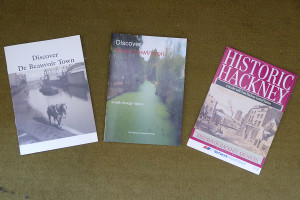The Friends of Hackney Archives publish the Hackney History journal, 20 volumes have been produced to date – here is a list of contents. The Editor, Robert Whytehead, welcomes contributions, if you would like to publish an article in Hackney History please write to him here – The Friends of Hackney Archives, c/o Hackney Archives, Dalston CLR James Library and Hackney Archives, Dalston Square, London. E8 3BQ

Guides to three areas of historic Hackney, with suggested walks, have been published: Discover Stoke Newington – a walk through history (2006) with historic and contemporary illustrations, includes monuments in Abney Park, and much on the built development of the area, with curious architectural details; Discover De Beauvoir Town and environs (2003) covers De Beauvoir Square, the Regent’s Canal, Kinglsand Road, and east to Albion Drive and Mapledene Road; and Historic Hackney, a circular walk around the heart of Hackney, starting at Hackney Central station.
The Newsletter for members – The Hackney Terrier – is published three times a year, and provides updates on developments at the Archives, as well as useful links for local history researchers, and other items of interest.

We have three DVDs written and narrated by Hackney-born Bill Hall, with contributions from local residents and experts:
Stoke Newington
Traces the village’s history from Tudor times, looking at its churches and other historic buildings. It’s rich non-conformist heritage, with a strong Quaker presence, as well as early Jewish connections. Notable literary links include Daniel Defoe, Anna Sewell, and Edgar Allen Poe. 110 minutes, colour and black and white.
Four Hackney Houses
Once a desirable rural village, Hackney attracted wealthy residents with large houses and estates. The first film looks at Brooke House, a royal possession where a dramtic meeting was held between Henry VIII and his daughter, Mary. Enlarged by Thomas Cromwell, in the mid 1700s it was radically altered to become a mental asylum. The second film looks at three houses, Balmes, the home of Sir George Whitmore, Lord Mayor of London and a leading royalist. Barbers Barn, in Mare Street, the home of a colonel in Cromwell’s army. Shacklewell, successively home of three wealthy families, the Herons, the Rowes, and the Tyssens. 120 minutes, colour and black and white.
Church Street, Hackney – The Narrow Way
The story of old St Augustine’s church, it’s rebuilding by rector Christopher Urswick, cleric and diplomat to Henry VII, demolished in 1797. The Church House built in front of it by Urswick, replaced by the old town hall; and the Black and White House on the site of the bus garage. Other lost buildings on Narrow Way included a lost tavern and pleasure garden, the `Manor House’, and the mysterious Templar’s House.
The current issue of The Hackney Terrier newsletter is circulated to members only, however back copies are available.
If you would like to purchase any of the above, see the pricelist here, including mailing costs, and the order form here ; payment to FoHA can be made by cheque or bank transfer. Please check availability by emailing hackneyhistory@gmail.com. They are also sold at Hackney Archives who can take payment by debit card (including over the phone) or cash. Some local bookshops stock our publications, including Stoke Newington Bookshop, Stoke Newington High Street.
